If a couple of years ago, acid peelings were made in a beautician's office, now cosmetic companies produce these home care products, though with a smaller concentration of the active substance. If you comply with the manufacturer's recommendations, you will not receive a chemical burn, but only speed up the regeneration of skin cells - make the skin soft, get a uniform color, get rid of rashes. will introduce you to popular products and existing components that you can use at home.
Types of acids
The first thing you should know about acids is that there are two main types in skin care products: alpha hydroxy acid (AHA) and beta hydroxy acids (BHA). Both classes of acids help to depart the skin, but there are still differences between them. According to Dr. Nava Greenfield, a dermatologist from Schweiger Dermatology Group, the main difference between them lies in a chemical structure that affects how each type of acid penetrates into the skin. For example, ana soluble in water and exfoliate, destroying the outer layers of dead skin cells. Meanwhile, BHA, like salicylic acid, soluble in oil, so they can penetrate into the pores and help clean them. According to Greenfield, among these two classes, the most popular acids for skin care are salicyl (BHA) and glycolic (ana). But there are several other types of acids, which complicates the choice of the desired product.
Salicylic acid
Salicylic acid belongs to the type of BHA acids. According to the American dermatologist Robin Gmarek, this acid really penetrates deep into the pores. Salicylic acid exfoliates the top layer of skin cells, which makes it an effective means in the fight against rashes. After use, the skin is cleared of dead cells, which makes it shining and soft to the touch. Salicylic acid is a salicylate that refers it to the same family as aspirin - it is forbidden to use those who have an allergy to this medicine. However, as well as aspirin, salicylic acid also has anti-inflammatory properties that can calm the skin and minimize irritation after use. Many labels for acid-based products are the percentage of used acid, informing consumers about the estimated effect on the use of the product. Dermatologists advise to choose products, in the active part of which will be 1-2 percent of acid: salicylic acid refers to a potent one, so it is necessary for the skin the minimum amount in the composition.

Do not be afraid to use acids
Photo: unsplash.com.
Glycolic acid
Glycolic acid (AHA) is a chemical exfoliant, which destroys and removes dead skin cells on the skin surface. After use, pigmentation is reduced, the face becomes lighter, it becomes even color. After removing dead cells, the skin becomes more moistened - it absorbs the leaving cosmetics that you use at home. Also, glycolic acid enhances the production of collagen - protein responsible for the elasticity and speed of skin restoration. Although, mainly glycolic acid is useful for preventing skin aging, it can additionally be used to treat acne. Dermatologists note that glycolic acid is well tolerated by most skin types. When searching for products with glycolic acid for home care, cosmetologists advise you to choose a concentration from 10 to 15 percent.
Lactic acid
Milk acid, one more ana, similar to Glycolic, but acts a little softer. By giving, Cleopatra itself, knowing the content of low-percent acid in milk, took dairy baths to update skin cells and giving it softness. Products with lactic acid are recommended to everyone who is tired of dry skin. It can also be used to align the skin relief - eliminate the effects of acne and small rashes. Milk acid, like glycolic, is well tolerated by most skin types. For home use, foods with lactic acid must be with a concentration of 10 percent or less, with a pH of about 3.5-4.
L-ascorbic acid
L-ascorbic acid is a vitamin C derivative, which is most often used as an antioxidant on the skin. The use of antioxidants slows the aging of the skin cells, enhances the production of collagen and purifies the pores of the skin. Products with this acid dermatologists are recommended to apply in the morning, and after covering over with moisturizing and sunscreen. Dr. Angela Lamb, Dermatologist and Director of Dermatology Practice of the Faculty of Westside Mount Sinai in New York, noted that Vitamin C also can help align skin tone and good to update cells. The concentration of vitamin C in products should be from 10 to 20 percent.
Ferulic acid
As well as vitamin C, ferulic acid is used as an antioxidant, and also prevents and treat pigment stains. Dermatologists recommend using serum and creams with ferulic acid in front of moisturizing and sunscreen every morning. Ferulic acid has a "weak action" and is used rather as a stabilizing agent, so the actual percentage of acid content is usually not specified on the product label.
Contraindications for the use of acids in care
If you have an irritated or cracked skin, visible acne, you should not use acids - it is better to seek advice to the dermatologist. As you now know, the majority of popular acids are exhausting cells, which means that they get rid of the surface protective layer of the skin. After using acids, the skin becomes sensitive to the sunshine - always use a wide range of actions with a wide range (UVA plus UVB) SPF 30+ and apply it every two or four hours. In addition, acids should not cause burns or skin irritation. You can feel a little tingling when applying the product, but not after it is removed.

Observe the manufacturer's recommendations
Photo: unsplash.com.
You must notice the improvement in the condition of the skin during the week or two after use - smooth complexion, softness of the skin, its lightening. The visible result on shallow wrinkles will be noticeable after 12 weeks or later. Before using a new product, consult a doctor - a dermatologist or cosmetologist.
